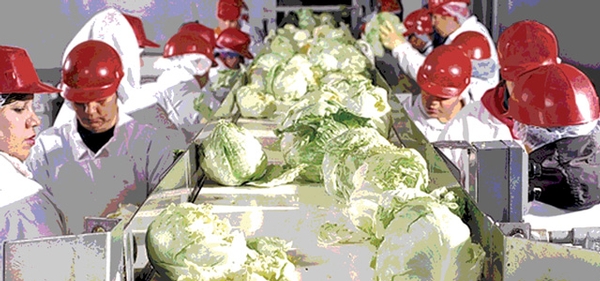Reported illnesses from food-borne causes have remained constant over the past few years, after dropping significantly in the late 1990s and the early years of this decade. The number of recalls, however, has risen significantly. The overall number of recalls, many of them reported extensively in the national media, rose sharply in 2007 over 2006, and the numbers appear to be increasing again this year.
In 2006, the Federal Safety and Inspection Service reported 34 recalls and 2 public health alerts. Last year, those figures increased to 55 and 4, respectively, and through March of this year, the totals were 12 and 1. The Food and Drug Administration reported 120 food and beverage recalls in 2006, 157 in 2007, and through March had reported 42 in 2008.
In addition to frequency, the size of the recalls over the past few years has increased as well. Records were set in meat recalls, and several large companies in the meat and produce industries either collapsed under the weight or were severely crippled as the costs of massive recalls of ground beef, spinach, pet food, pot pies and other food products gouged their bottom lines.
Contributing to these recalls is a lack of dedication to or total lack of effective food safety training. Too often, food processors tend to look at such training as a cost center, and provide the absolute minimum required to cut costs in an increasingly competitive environment. That is a major mistake because inadequate training in the present environment is an invitation to disaster.
Building a Food Safety Training Program
The nuts and bolts of food safety training are closely linked to a Hazard Analysis and Critical Control Points (HACCP) plan Sanitation Standard Operating Procedures (SSOPs) and Current Good Manufacturing Practices (CGMPs). Food safety training protocols can only be implemented after an effective HACCP plan has been developed and instituted. Appropriate training, obviously, varies considerably from business to business, and adopting a one-size-fits-all program is a common mistake. You, and more importantly, your employees know your business the best, and the more that knowledge is deployed, the better your training and food safety record will perform.
The single most important piece of a food safety training program is establishing company-wide buy-in. If top management views such a program as a mere regulatory obligation, employees will quickly get the message that paying lip service to training is adequate, and standards on the production floor will quickly slip.
HACCP was introduced in 1996 by federal inspection agencies to shift the food industry from an inspection-driven enterprise to a prevention-driven one. Responsibility was in effect shifted from the various inspection services to the processor, and processors were charged with establishing systems that would prove to inspectors that all necessary steps in the food manufacturing chain, from training new employees to proper cleaning of machinery and premises, were being taken— every time. Producers who do not take that responsibility seriously are in danger of being shut down temporarily—or worse.
Apart from enterprise-wide buy-in, the next most important consideration in building a training program is acquiring expertise. Training is an increasingly complex undertaking, and it requires constant repetition and creativity in delivering the message. This can be provided in-house, with hires of experienced training professionals in the human resources department, or third-party providers can be contracted to set up and run a training program. For smaller companies, the latter solution might be the better one, since a third party has experience with other processors and can spot weaknesses more quickly, having seen other clients make the same mistakes. Larger companies, which require more customized and more frequent training, may be better off investing in their own training department. These are just general recommendations; circumstances vary widely from company to company.
Who Should be Trained?
The short answer is: Everybody. Food safety is Job One, and every employee at some point touches the food safety system. In an age of global supply, for instance, the purchasing department is less likely than in the past to know all ingredient suppliers and their track records intimately and the chances of obtaining substandard or even unsafe ingredients increase rapidly if buyers are not trained to ask the right questions and demand the right documentation. Many foreign suppliers operate under food safety systems that are far more lax than are those of the United States. Similarly, product development staff must be aware of the food safety ramifications of every decision they make. Each new ingredient introduced to the production floor creates new food safety vulnerabilities.
Obviously, production workers and sanitation crews require intense training, but others, such as maintenance crews, are often ignored. The food safety consequences of a sloppy weld may be obvious, but they are often overlooked. Senior management must be aware of the food safety program and constantly updated; small problems on the floor can quickly snowball if senior managers are not keeping an eye on the entire enterprise.
Many forward-looking companies are requiring their sales forces to take extensive training. While they may not directly touch food safety, exhibiting extended knowledge of the steps their company is taking to guarantee a fresh, wholesome product is reassuring to customers and can often act as a point of differentiation in an increasingly competitive marketplace.
How Often Should Training Take Place?
The production plant is an everchanging organism and food safety training should keep up with those changes. New machinery, new products and new staff move in constantly, and SSOPs and the overall HACCP plan can quickly become out of date. Every new person should be fully trained before they are allowed on the production floor; hoping that fellow employees with show them the ropes only increases the chances that bad habits will become institutionalized. An experienced worker is not necessarily a good teacher.
Before they even see the production floor, applicants should be fully trained in the food safety aspects of their jobs. This is the time to set rules and communicate expectations. Training at all levels of the corporation should be measurable; electronic training regimes are not only more interactive, but they provide documentation that not only was training conducted, but that the associate learned the material. A quick slide show is not enough; the results must be measurable, and that measurement should be part of your HACCP plan.
While it is wise to eventually crosstrain employees and test them on company- wide procedures, early testing should be specific to their jobs and should be actionable. This immediacy will increase interest in and retention of the information. Keep ongoing training sessions to short, actionable presentations, customized to the associate’s actual work function.
Company-wide training should be incorporated into the corporate calendar, just like financial and planning functions. There should be yearly, quarterly, monthly and even weekly schedules with measurable goals and results. Additionally, each time a new piece of production machinery is installed or a new product introduced, a HACCP team should update SSOPs and test the new arrival against the overall HACCP plan. For instance, adding a sausage product to an existing line of meatballs and burgers introduces new concerns in smoking, safety of casings and coatings and the like. Adding fresh herbs to existing recipes introduces threats that may not exist with dried seasonings.
Building a Robust Food Safety Training Program
Whether you are developing a program from scratch or restructuring your training, the following tips will ensure that the program delivers on its promises.
1. Even if you plan to administer the training in-house, hiring a third party to conduct a training-needs assessment will focus an agenda-free eye on your needs and potential shortcomings. The assessment should include a thorough walkthrough of all of your operations, a full audit of past performance and interviews with and testing of your staff.
2. Establish a regular employees’ committee on food safety. Your staff are the people who see close-up potential problems and cases where the tools they need to perform their jobs are lacking. Asking their advice, and acting on it, internalizes the food safety message and creates buy-in at all levels.
3. Pre-test and post-test. Determine the effectiveness of your training program by tracking improvement in test results. Be certain to test top management along with production staff.
4. Establish incentive programs for food safety functions. Make it clear that food safety is a top priority for management, and that employees who excel will be recognized and rewarded. This is key in establishing a culture that safeguards your product line, your brand name and, in the end, your business itself.
5. Cross-train top employees so that key positions are never filled by a newcomer. Every key position in your company should have a back-up person who is fully trained in the function and food safety needs of that position to avoid creating a critical weakness in your overall plan.
New Technologies
There are many new technologies available today that make training easier, more specific, more productive and in the end, more effective. These can range from the ubiquitous digital camera to highly advanced interactive computer programs that probe and confirm each employee’s expertise.
DVD presentations, which can incorporate humor, specific task-oriented advice and production values that keep employees engaged are available from many vendors. These can often be customized to include your plant and your production tools.
Many major processors are using interactive techniques to engage and inform their employees, many of whom are not computer-literate and respond poorly to older computer-assisted training. One such is a polling system that provides employees with a device similar to a remote control. They are then are shown brief, specific presentations on one of literally hundreds of subjects. They are then questioned about what they just saw and required to answer using the remote device. A facilitator can then determine instantly how well the lesson was absorbed, who needs further training and develop the documentation to prove that employees have been trained.
Web seminars, or webinars, are available on a variety of topics from vendors, regulatory agencies, and industry associations. With the cost of travel exploding, these can be a wise investment in time, keeping key personnel up to speed in a rapidly changing food safety environment.
New Developments in Food Safety Training
No matter how robust your training may be, events and new capabilities will continue to overtake it. For instance, a major West Coast meat processor is on the edge of bankruptcy after the largest recall of ground beef in history earlier this year. It was not E. coli or Listeria that brought the company down; it was the way it handled its animals at slaughter.
While humane handling is not a pure food safety issue, it has ramifications that affect food safety. So-called downer cattle, which were prodded and even carried to slaughter, often have compromised immune systems, and may have been ill for an extended period of time before becoming unable to walk. That can affect both the safety and quality of the meat. Many alert processors have introduced a humane-handling component to their food safety training, whether to monitor their own slaughter operations or to certify that meat from their suppliers came from animals that were treated humanely. It never hurts to cover your bases.
Processors are also becoming more sensitive to the role contagious human diseases play in food safety. Environmental contamination and animal disease receive the majority of attention, but many suspect that Typhoid Marys in a plant may actually be responsible for at least as much food-borne illness.
The latest is norovirus, which this spring shut down a New York entertainment park when over 400 people became ill in a single day. Pathogens that can cause diseases after an infected person handles food include the following: Norwalk and Norwalk-like viruses, Hepatitis A virus, Salmonella typhi, Shigella species, Staphylococcus aureus, and Streptococcus pyogenes. Anyone who exhibits symptoms from any of these pathogens should be examined and sent home, and told to stay there until they have been symptom-free for at least 24 hours or a doctor clears them for return to work. This runs counter to the usual "make it to work unless you’re at death’s door" policy of most businesses, but in the field of food safety it is yet another case of an ounce of prevention being worth a pound of cure.
Time and temperature control issues are pushing the training issue out of processors’ plants and throughout the entire cold chain. Foodservice has fairly strict controls about maintaining the cold chain, but this is less developed in the retail world, and major retailers are pushing the function to their vendors. That may mean training truck drivers who are not your employees or even training receiving and floor personnel in major retail chains; if your product results in illness and/or recalls, retailers are likely to blame you, not themselves.
Food safety training is not a luxury, nor just a pesky governmental regulation. In the past year, Topps Meat Co., the largest supplier of ground beef products on the East Coast, closed its doors almost overnight after a massive national recall of frozen burgers and other products. Westland/Hallmark, which was one of the largest suppliers of ground beef on the West Coast, is still technically in business, but it recently received a bill for $70 million from USDA for ground beef in the national school lunch program that had to be destroyed and replaced. Perhaps increased attention to food safety training would have averted these recalls.
Food safety training is as vital to your enterprise as every other kind of insurance. Take that to the bank.
Read the sidebar "Food Safety: A Dynamic Enterprise Q&A with Mike Cramer"
Pete Hisey is a Chicago-based writer. He has over 20 years of experience in the food processing, retail, banking, and electronics industries. He has written many technical and scientific articles centering on animal health, food processing procedures, and governmental regulation.
Food Safety: A Dynamic Enterprise Q&A with Mike Cramer
Mike Cramer, corporate director of quality assurance at Houston-based Midland Foods, a major supplier of ready-to-eat products, says that food safety training is an ever-changing, dynamic, and company-wide function.
Food Safety Magazine: You describe your food safety program as dynamic. In what way?
Mike Cramer: A company is a living organism, a dynamic enterprise that is constantly introducing new people, new products, and new processes. We are constantly changing.
Food Safety Magazine: What are the most recent issues that have impacted your program.
Mike Cramer: The most recent is concern about humane animal handling. We have sent inquiries to all of our suppliers who slaughter animals, asking for an annual humane-handling audit. Our next step will be to start auditing them ourselves. This may not be a pure food safety issue, but animals who are mistreated are under stress, and that compromises their immune systems, so they are more susceptible to disease. At the very least, stress creates meat of lesser quality.
Food Safety Magazine: What other new programs have you instituted?
Mike Cramer: For one, we’ve instituted an annual "commando swab" to search for environmental Listeria. We blanket every plant with swabs to find sources of Listeria we don’t normally test. We’ve also moved to weekly testing in all plants, above USDA requirements.
Food Safety Magazine: Apart from humane handling, what other issues are affecting your safety training?
Mike Cramer: A major one is the increased globalization of the food industry. Like everyone, we’re under pressure from rising costs for commodities and energy. Consequently, we’re sourcing worldwide to find some savings. But that introduces risk, because in most cases, we have never done business with these suppliers before. We have enhanced our training programs for our purchasing and product development people, so that they’re aware of the added risk. We’re also working with a third-party food safety firm, HACCP Consulting Group, that is familiar with foreign compliance issues and can tell us who is safe to do business with.
Food Safety Magazine: With the increased testing regimes in your plants, are you seeing increased positives?
Mike Cramer: Actually, it’s the opposite. The more we test, the less we find. I think it’s because everyone is even more focused on sanitation, knowing there’s a test coming every week.
Food Safety Magazine: What led you to invest so much in training and food safety?
Mike Cramer: It comes from top management. We know that catching problems through inspection is not as good as preventing them through systems.




